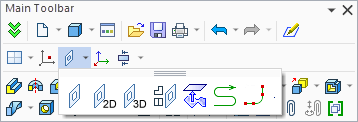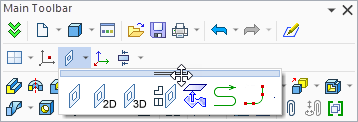Toolbars of Textual Interface |
  
|
A toolbar is a set of buttons for launching system commands. Toolbars are used instead of the ribbon in textual interface of the T-FLEX CAD. Textual interface may be enabled using the Customize command.
Multiple different toolbars may be displayed simultaneously.
![]()
Following toolbars are available:
•System Toolbar
Contains set of tools for quick defining of parameters of elements being created or edited. Also contains elements selection tools, thus replacing the Filter Toolbar. Enabled only in textual interface by default, but can be enabled in ribbon interface manually.
•Main Toolbar
Contains button sets, which can be selected by the user or provided automatically by the system depending on the current task and toolbar options.
•Main Menu
Has the same content as the Text Command menu, i.e. contains all main commands of the system grouped in drop-down textual menus in accordance with their sphere of usage. Enabled only in textual interface by default, but can be enabled in ribbon interface manually.
•View
Contains frequently used commands for managing the display of drawing and 3D scene and customizing parameters of drawing pages. Enabled both in textual and ribbon interface by default.
•Full Screen Mode
Contains commands for activating the full screen mode and presentation mode.
•Context
Contains commands fro working with a 3D fragment in context of its parent assembly.
•Custom toolbars
Contain sets of commands selected by the user.
Any of the toolbars can be enabled using the Customize command. It also allows managing the content of custom toolbars.
Any of the toolbars can be placed along any of the borders of the system window or be floating. Floating toolbars have headers. Size of a floating toolbar can be changed by dragging its contour with ![]() .
.

Nested toolbars
Some commands in toolbars are grouped in accordance with their functions, so that only a single icon of a group is displayed by default. Other commands of the same group can be accessed by pressing the ![]() button located to the right of the currently displayed command. Pressing such button invokes a nested toolbar containing all commands belonging to the group.
button located to the right of the currently displayed command. Pressing such button invokes a nested toolbar containing all commands belonging to the group.

A nested toolbar can be converted into a separate toolbar by moving the cursor over its header and dragging it with ![]() .
.

Commands belonging to a nested toolbar may be moved into its parent toolbar by pressing the ![]() button located at the right edge of the nested toolbar.
button located at the right edge of the nested toolbar.
